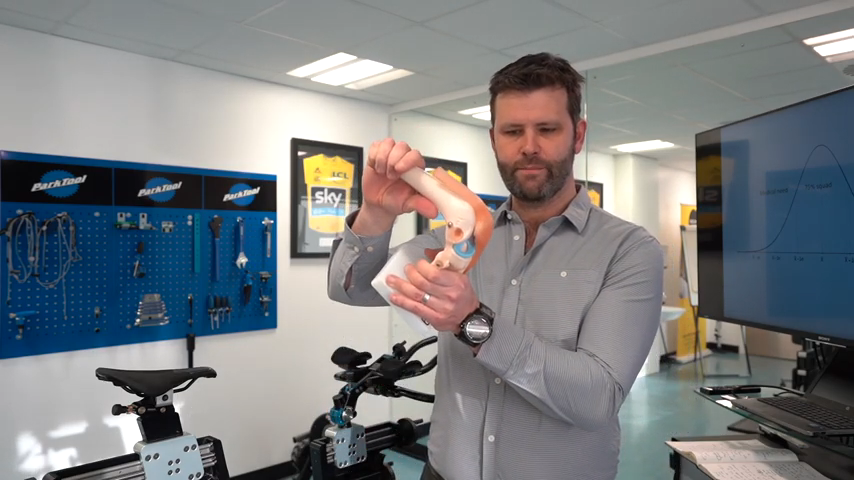Cycling Knee Pain Explained

If you think about it, what's the first thing anyone does when they're injured?
If you can't run, your physio will often put you on a bike. Go for a knee operation first thing you do is cycle. And why is that? If we understand that. It's because cycling has hardly any eccentric forces to control - it's a two dimensional sport, not three dimensional like football, where you're running fast and changing direction, so it has lots less injurious forces going on in it, and it's great, because as we all get older and wear out, one thing we can do maybe is not run marathons anymore, but you see a lot of 70 year old guys riding bikes really hard and that's the reason why. Having said that, there are cycling injuries.
What are the top three cycling injuries?
- Knee
- Shoulder
- Lower back
Knee, shoulder and lower back. So let's cross off shoulder first of all. The reason why it appears so high in that, is because when people fall off bikes, they break the collar bones basically. You fall from your bike, it's higher than a running position, and you fall on an outstretched hand and this bone takes it, and that's where you fracture. Well, we'll leave that alone for now, although we may well go into that at a later date and how you recover from that. Lower back is a whole other video, so today we're going to tackle the number one cycling injury which is the knee. The knee. So, what we're going to talk about: why is the knee the most injured joint in cycling? Well, if you look at a bike, our hips and pelvis are quite well supported by the saddle, and our foot and ankle are completely locked into a pedal, and quite often a carbon-fiber shoe. So foot's happy, ankle's happy, not much to do in control (unlike in running where there's the ground, and the trainer, toe off...) it's very, very simple.
Bottom - completely supported.
What's the one joint out there in the air?
It's the knee, and it's controlling all the power from the two biggest muscle groups in the body: your glutes and your quads.
If you're using them to pedal, the knee transfers all that power, between there and there, and that's why it's quite vulnerable, and that's why, even if you only cycle at 80 revolutions per minute, that's adding up to thousands of revolutions - pedal revolutions - where your knee is tracking through that cycling motion over a long ride. This is why setup's so important; cleat, pedal, saddle height, set back. This boy takes the brunt of it. And here's the oxymoron cycling's really good for knees. If you came to me and you had a really bad knee injury, say from your football, or rugby career, or the netball, I reckon almost anybody can cycle as long as you get the setup right, because the first thing any physio do is put you on a bike to help your knee rehabilitate.
But get it wrong, that set up, and you can end up with a knee injury. So obviously I'm not there with you, but I want to help you, so what can I tell you that might help you? Okay, so basically, if you're getting pain to the back of your knee, a very, a quite common cause is that your saddle is too high and you're having to reach too far to the pedal. So check your saddle height.
If you're getting pain at the front of the knee, in the kneecap, that can often be that your saddle position is too low.
We know that from good research basically as you're sitting too low, your patella gets more compressed and can cause pain here. If you get in pain at the incursion on the outside of the knee, that can quite often be that your iliotibial band - a large muscle band down that the outside of your thigh - is becoming too tight. Now that one's a little bit more difficult, you can treat the symptoms of that and make it feel a lot better by safe foam rolling your ITB band, releasing your glutes, that might need to be physio lead, you might have a go at yourself, but quite often iliotibial band pain, or pain on the inside of the patella that people often get from cycling, due to the iliotibial band pulling the patella that way on the knee cap, that can quite often be down to biomechanics and you might look at your pedal system you're using. For example, if you look at yourself now and walk across the living room, and if you walk like a duck with your feet out, and you're on a fixed pedal system like a Shimano or a Look that allows a little float this way, then this gets tightened up all the time, and lead to knee pain. So it can be a little bit more involved and complicated, but there's some hopefully helpful tips for you guys.
Related links: Knee Supports
Article image and text sourced from YouTube Creative Commons.
Text and image source: Phil Burt Innovation. License: CC BY 3.0